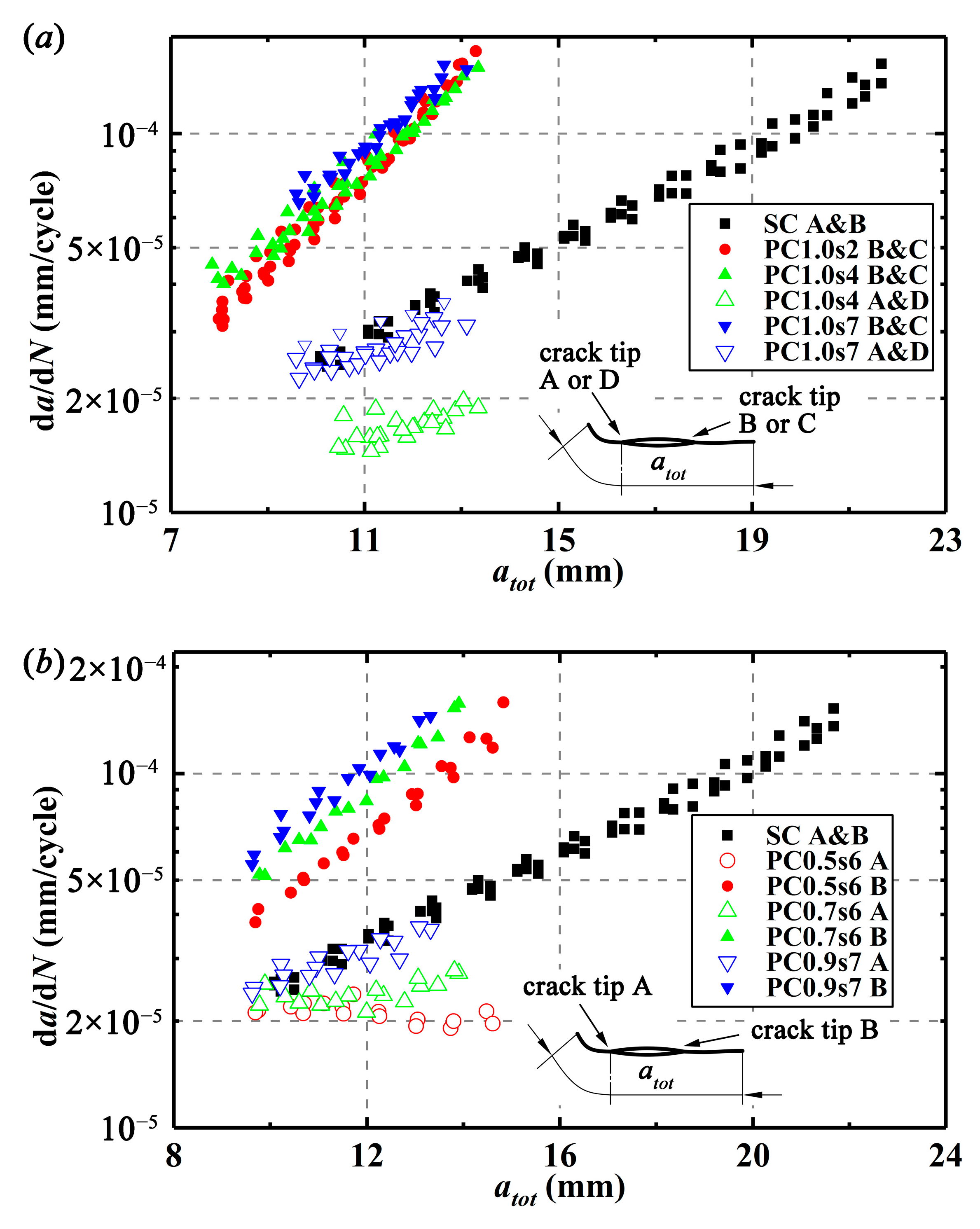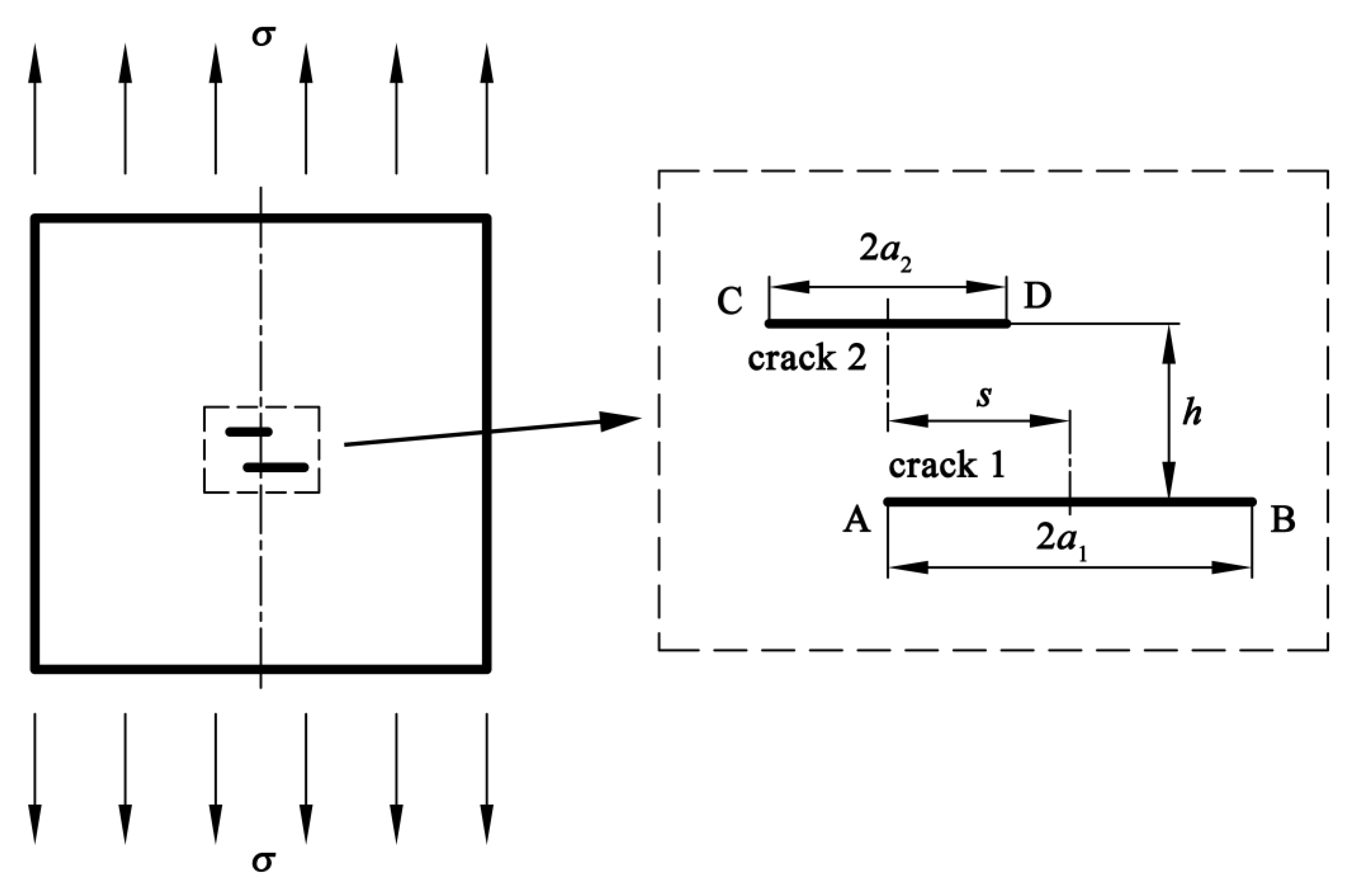3.2. Simulation Results of the SIFs
It can be found from
Section 2.3.2 that crack 1 is more “dangerous” than crack 2. Considering that for the double parallel cracks, Mode II SIF,
KII is much smaller than Mode I SIF,
KI for a given
s and
h [
11], therefore, Mode I SIF,
KI, at crack tips A or B in crack 1 is calculated. In addition, the SIF of a single crack in an infinite plate with length of 2
a1 is also calculated by Equation (6) for comparison.
The ratio of the SIF of crack 1 to the SIF of the single crack, KI/KI0, is defined to represent interactions of the double parallel cracks. Particularly, if the value of KI/KI0 is less than 1, it can be considered that the crack tip receives a shielding effect on the SIF from the adjacent crack, and if KI/KI0 is greater than 1, the crack tip receives an enhancement effect on the SIF. Crack interactions can be neglected if KI/KI0 is close to 1.
The value of
KI/
KI0 can be calculated from the geometrical parameters,
h,
s,
a1, and
a2. Therefore, three dimensionless parameters,
H,
S, and
Ra, are defined as follows to find the expressions of
KI/
KI0.
Figure 8 depicts relationships between the dimensionless offset distance
S and the value of
KI/
KI0 in crack 1 at
H = 0.833 with different
Ra. It is found that crack 2 has different effects on crack tips A and B. When the value of
S is equal to 0, crack 2 presents a shielding effect on the SIFs at the two crack tips of crack 1. With the increasing
S, the shielding effect on the SIFs at crack tip A increases but decreases at crack tip B. When
KI/
KI0 at crack tip A reaches the minimum value or the SIFs at crack tip A experience the greatest shielding effect, the SIFs at crack tip B start to change from the shielding effect to the enhancement effect. As the value of
S continues to increase, the shielding effect on the SIFs at crack tip A decreases, while the enhancement effect at crack tip B increases. When
KI/
KI0 at crack tip B reaches the maximum value or the SIFs at crack tip B experiences the greatest enhancement effect, the SIFs at crack tip A change from the shielding effect to the enhancement effect. With further increasing
S, the enhancement effect on the SIFs at crack tip A increases, while decreases at crack tip B. When double cracks are not overlapped and crack tips A and D are close, SIFs at crack tip A receive the greatest enhancement effect. As the value of
S is large enough, or in other words, the two cracks are offset enough, the crack interaction vanishes.
Changes of
KI/
KI0 at crack tips A or B with the increasing
H at
S = 2.333 are drawn in
Figure 9. It seems that with the increase of
H, the enhancement effect on SIFs at crack tips A or B decreases, and finally, vanishes until the distance of the double cracks is large enough. It is also observed from
Figure 8 and
Figure 9 that the parameter
Ra also has influence on the interactions of the double parallel cracks. Actually, a larger
Ra or a close length of the double cracks will produce a greater shielding or enhancement effect with the change of
S and
H.
As the enhancement effect is more “dangerous” compared with the shielding effect in the crack propagation process, more attention should be paid on the enhancement effect at the “dangerous” crack tip, or crack tip B, in the following analysis. Corresponding to the value of
KI/
KI0 at crack tip B in
Figure 8b changing from the shielding effect to the enhancement effect, the dimensionless offset distance is denoted as
S1, which can be obtained by Equations (10) and (12). Corresponding to the maximum values of
KI/
KI0 at crack tip B in
Figure 8b for the greatest enhancement effect, the dimensionless offset distance is denoted as
S2, which can be expressed by Equations (11) and (13).
With the sufficient numerical results, KI/KI0 at crack tip B can be expressed with H, S, and Ra as follows:
Equations (14) and (15) are valid for 0.5 ≤
Ra ≤ 1,
H ≥ 0.1 and
S ≥
S1. With
KI/
KI0 obtained from Equations (14) and (15) and by applying Equation (6), the SIF at crack tip B can be easily calculated with the enhancement effects of the adjacent crack.
Table 4 lists the comparison results of the SIFs calculated by Equations (14) and (15) or by FEM. It can be found that the relative errors are less than 5.0%, which is acceptable in engineering.
3.3. Mechanical Explanation of the Crack Interactions
It is found from
Figure 8 that crack tips A and B experience the shielding effect or enhancement effect depending on different offset distance. Considering that
KII is much smaller than
KI, implying that the shear stress is much smaller than the tensile stress, therefore, the tensile stress distributions around the crack tips along the loading direction are investigated to find out the mechanism of the crack interactions from mechanical point of view.
Figure 10 shows the tensile stress distributions of the single crack and the double equal cracks with
S = 1.0,
S = 2.333, and
S = 5.667. As shown in
Figure 10b, because of the shielding effect, the tensile stress around crack tip A decreases, leading to the decrease of the SIF at crack tip A. However, the tensile stress around crack tip B is enhanced and thus, SIF at this crack tip is raised as the effective length of two cracks increases. However, it is found from
Figure 10c that when
S is increased to some value (see
S > 2 in
Figure 8a), the tensile stress around the crack tips A and D is also enhanced, and the SIFs at these crack tips increase. In addition, it is found from
Figure 10d that if the double cracks are far away, crack interactions fade away.























